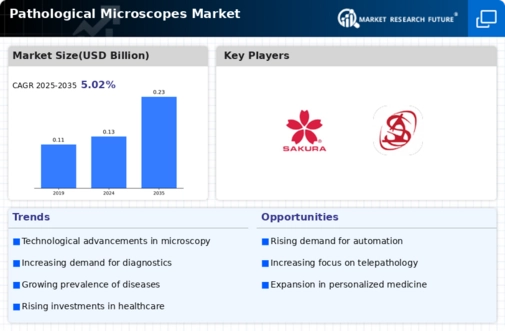Market Analysis
In-depth Analysis of Pathological Microscopes Market Industry Landscape
The pharmaceutical industry is undergoing a profound technological transformation, propelled by a surge in research and development endeavors spearheaded by both private and public partners. This paradigm shift is redefining the landscape, with a substantial portion of pharmaceutical players channeling significant investments into the creation of novel drugs. As these research and development activities intensify, there is a concurrent rise in the utilization and demand for cutting-edge instruments, prominently among them, pathological microscopes. The evolving role of pathological microscopes, particularly in the realm of drug discovery, stands as a pivotal force propelling the expansion of the pharmaceutical instrument market. A primary catalyst for the burgeoning demand for pathological microscopes within the pharmaceutical industry is their indispensable role in the intricate process of drug discovery. The meticulous examination and analysis of cellular structures and pathological samples underpin the development of new drugs. Pathological microscopes play a crucial role in this investigative journey, providing pharmaceutical researchers with unprecedented clarity and precision in their observations. The increasing integration of these advanced instruments in the drug discovery phase not only expedites the research process but also enhances the accuracy of results, contributing to the overall efficiency of pharmaceutical research and development. Highlighting the financial commitment of the pharmaceutical industry to research and development, the International Federation of Pharmaceutical Manufacturers & Associations reported that, in 2015, the global pharmaceutical sector allocated a staggering USD 149.8 billion towards these endeavors. This colossal investment underscores the industry's dedication to advancing scientific knowledge and fostering innovation. A significant portion of these funds is directed towards the adoption and development of cutting-edge technologies, with pathological microscopes emerging as key components in the arsenal of tools utilized by pharmaceutical researchers. The symbiotic relationship between the pharmaceutical industry's research and development activities and the demand for pathological microscopes is indicative of a broader trend in technological evolution. As pharmaceutical companies strive to stay at the forefront of innovation, the integration of advanced instruments becomes imperative. Pathological microscopes, equipped with state-of-the-art imaging capabilities, empower researchers to delve into the microscopic intricacies of cellular structures, facilitating a deeper understanding of disease mechanisms and potential therapeutic targets. Beyond drug discovery, pathological microscopes also play a crucial role in quality control and assurance processes within the pharmaceutical manufacturing pipeline. The meticulous examination of pharmaceutical products at a microscopic level ensures compliance with stringent quality standards, minimizing the risk of defects and ensuring the production of safe and effective medications. The pharmaceutical industry's dynamic landscape is shaped by an intensification of research and development activities, reflecting a commitment to innovation and scientific advancement. The escalating demand for pathological microscopes within this context is not only a consequence of this evolving landscape but also a driving force behind the industry's technological transformation. As the pharmaceutical sector continues to invest substantially in research and development, the significance of advanced instruments like pathological microscopes in shaping the future of drug discovery and manufacturing processes cannot be overstated. The financial commitment made by the industry underscores its recognition of the pivotal role played by these instruments in pushing the boundaries of scientific understanding and therapeutic development.





Leave a Comment